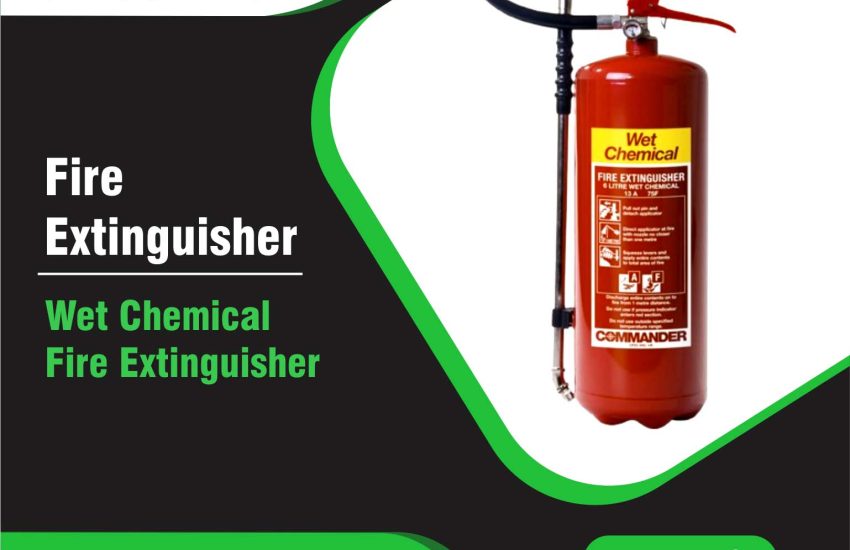Wet Chemical Fire Extinguisher Cost A wet chemical fire extinguisher is essential for tackling fires caused by cooking oils and fats. These fires typically occur in commercial kitchens and require specialized fire safety equipment. Wet chemical extinguishers effectively manage Class K (US) or Class F (UK) fires, which involve hot oils, fats, and grease. This article explores the specifications, features, and benefits of wet chemical fire extinguishers, helping businesses and individuals make informed safety decisions.
What is a Wet Chemical Fire Extinguisher?
A wet chemical fire extinguisher is designed to suppress fires involving cooking oils, fats, and grease. It uses a chemical solution that cools the flames and forms a thick foam layer. This foam helps to suffocate the fire and prevents it from re-igniting. These extinguishers are ideal for use in kitchen appliances like deep fryers, grills, and stovetops, where hot oils are common.
Key Specifications of Wet Chemical Fire Extinguishers
Choosing the right wet chemical fire extinguisher requires understanding its key specifications. Below are the main factors to consider when purchasing a wet chemical fire extinguisher:
1. Fire Rating
Wet chemical fire extinguishers are rated for Class K or Class F fires, depending on the region. This rating indicates the size and type of fire the extinguisher can handle. For instance, a 6L wet chemical extinguisher is commonly rated for fires in commercial kitchens involving cooking oils and fats.
2. Capacity
Wet chemical extinguishers come in various sizes, ranging from 1L to 12L. Larger capacity extinguishers offer longer discharge times, making them more suitable for larger or more intense fires. Common sizes include 6L, 9L, and 12L.
3. Operating Pressure
These extinguishers typically operate under pressure between 10 to 15 bars, depending on the model and capacity. The pressure ensures the wet chemical solution is expelled forcefully to suppress fires effectively.
4. Discharge Time
The discharge time for a wet chemical fire extinguisher generally lasts between 8 to 20 seconds, depending on the size and design. Larger extinguishers often offer longer discharge times, which are beneficial for more substantial fires.
5. Discharge Range
Wet chemical extinguishers typically have a discharge range of 2 to 3 meters. This allows the user to direct the extinguishing agent at the fire’s base while maintaining a safe distance from the heat source.
6. Activation Mechanism
These extinguishers feature a pull pin and lever system for easy activation. Some models come with an additional hose and nozzle, giving users better control during discharge.
7. Nozzle Type
The nozzle is designed to spray the wet chemical agent in a fine mist. This mist helps to cool the oil or fat and forms a protective layer to prevent the fire from reigniting. Many nozzles also include a safety cap to prevent accidental discharge.
8. Temperature Range
Wet chemical fire extinguishers are effective across a wide range of temperatures, typically from -20°C to 60°C. This ensures they perform well in various environments, including commercial kitchens, where temperatures fluctuate.
9. Material and Construction
The body of the extinguisher is usually made from high-quality steel or aluminum, providing durability and resistance to corrosion. The extinguishing agent inside often consists of a mixture of potassium acetate, potassium carbonate, or potassium bicarbonate, formulated specifically for oil and fat fires.
10. Approval and Certification
Look for extinguishers that are certified by recognized standards organizations such as EN3 (European Standard), UL (Underwriters Laboratories), and FM (Factory Mutual). Certification ensures that the extinguisher meets safety and performance standards.
Why Choose a Wet Chemical Fire Extinguisher?
Wet chemical fire extinguishers are particularly crucial in environments that use cooking oils and fats. Here’s why they should be a key part of your fire safety plan:
Effective on Cooking Fires
Wet chemical extinguishers are designed specifically for fires involving hot oils. Unlike water or dry powder extinguishers, they effectively suppress cooking fires without the risk of spreading or making the fire worse.
Prevents Re-ignition
The foam produced by wet chemical extinguishers cools the fire and forms a protective layer over the burning oils. This helps to prevent the fire from reigniting, which is a common issue with cooking fires.
Safe for Kitchen Environments
Wet chemical extinguishers are safe to use in kitchens and food preparation areas. They do not create harmful residues or cause significant damage to kitchen equipment, unlike other types of fire extinguishers.
How to Use a Wet Chemical Fire Extinguisher
Using a wet chemical fire extinguisher correctly is crucial. Follow these steps:
- Pull the Pin: Remove the safety pin from the handle to unlock the device.
- Aim at the Base of the Fire: Stand a safe distance away and aim the nozzle at the fire’s base.
- Squeeze the Handle: Firmly squeeze the handle to release the wet chemical agent.
- Sweep Side to Side: Move the nozzle in a side-to-side motion to cover the entire fire.
Maintenance and Inspection
To ensure optimal performance, you must regularly inspect and maintain wet chemical fire extinguishers. Key maintenance tasks include:
Monthly Visual Inspections
Check the extinguisher for signs of damage, rust, or leaks.
Annual Servicing
Have the extinguisher serviced by a certified professional to ensure it is fully operational.
Replacement
If the extinguisher has been used or is near the end of its lifespan, replace it promptly.
Conclusion
Wet Chemical Fire Extinguisher Cost A wet chemical fire extinguisher is an indispensable safety tool for any commercial kitchen. Understanding the specifications, such as capacity, discharge time, and fire rating, helps you choose the right extinguisher. Regular maintenance and proper training can significantly reduce the risks associated with cooking fires. For kitchens and other high-risk environments, having a wet chemical extinguisher on hand is crucial for ensuring fire safety.


